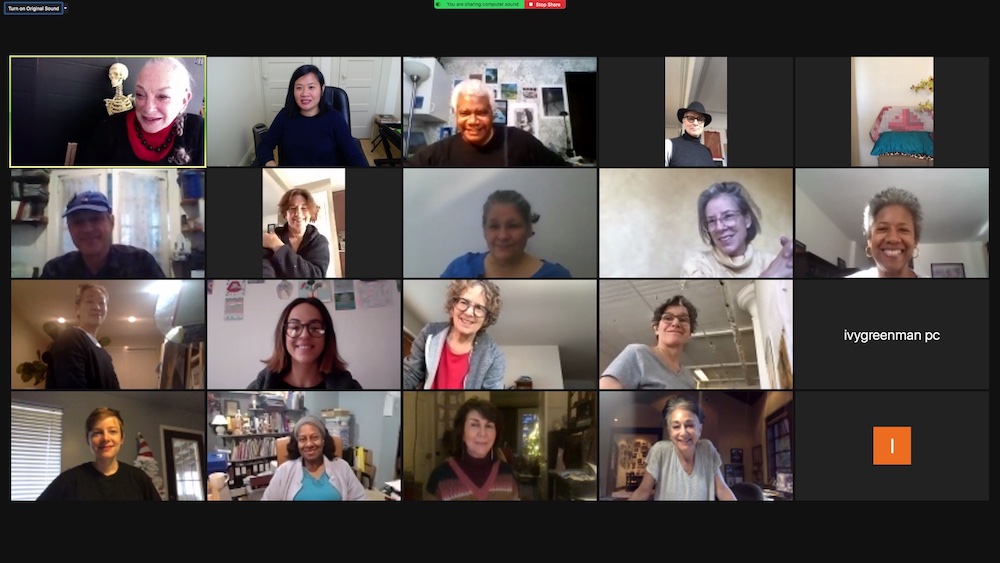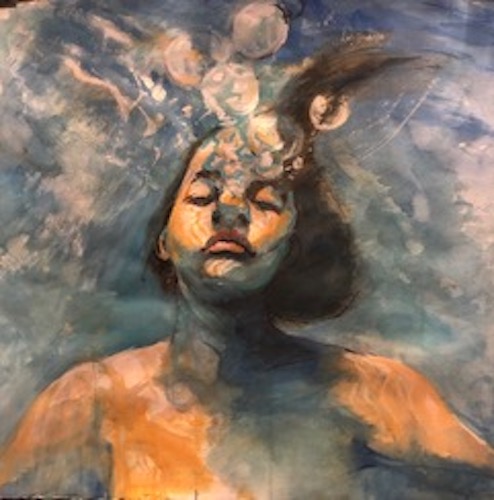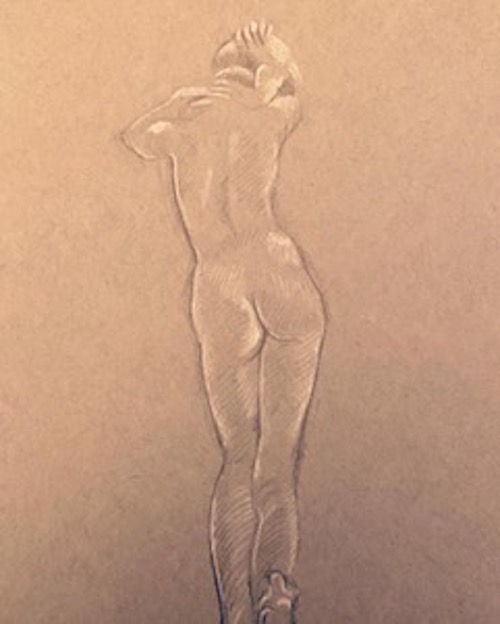 [1]
[1]From Sherry Camhy’s “Master Class: Basics & Beyond”
This past spring the COVID-19 virus spread throughout New York with deadly speed. Then came the extensive water damage to the Art Students League’s landmark building after Tropical Storm Fay. For the first time in its history, the building had to close, and its studios sat empty.
Thankfully, the League’s Board of Control and staff were there to provide a roadmap for a possible alternative to the distinctive style of personal mentoring that is at the heart of the Art Students League.
Zoom!
The experiment was started with reluctance and trepidation. Artists and technology are reputed to be like oil and water. We had to learn new computer skills on the fly. Fortunately, the League’s staff was there to answer questions, and we had a technical assistant partner to save the day for participants, models, and instructors to make Zoom work. From there, it was artists who had to figure out how the platform could meet the unique demands of an art school.
Zoom was magic. After so many countless days spent longing to be together with other artists at the ASL, it was like rubbing the genie’s lamp. With a quick click on a link, the computer screen was filled with friendly faces, new artists, former students, some now with children, day jobs, health issues, those quarantined or living far away.
Imagine that. No need to travel. Everyone could remain safely at home, even if home is Abu Dhabi, Alaska, Mexico, Madrid, England, France, China, Chicago, California, Cyprus, Korea, Texas, Woodstock, New Paltz, or from around the corner, in New York City.
 [2]
[2]Artists from everywhere could see each other, talk, share news, ideas, or questions, and listen, learn, draw and paint together. The ASL’s Zoom sessions have become one of the most stimulating, inspiring, enlightening, intellectually exciting experiences. The Art Students League has become a powerful network, a true league of international artists.
 [3]
[3]Participants can see each other and their names, create a virtual backdrop, or share glimpses into their art studios, kitchens, libraries, the view of Parisian streets, a garden in London. They can choose to have everyone–or no one—see their work. They can listen to supportive suggestions and be encouraged to try new things in new ways. Best of all, they can hear their work acknowledged, appreciated, praised. Artists can be in their own space, doing their own thing, but no longer feel alone. The resulting artwork has been extraordinary to see.
The video conferencing platform Zoom offers a different kind of learning experience, a natural fit for lectures, demonstrations, art history. But what about for studio workshops?
What about models? With the guidance of the ASL’s model services manager, models shifted from the standard gray studios to dynamic environments of their own creation—with proper lighting, backdrops, props, and places to do inventive poses. While studying the nude is crucial to the training of any figurative artist, the opportunity to work with a clothed figure in unusual settings is rare, precious, and entirely possible on Zoom. One of our models posed as Spiderman on a rooftop, another in an evening gown.
Through Zoom, art students are no longer limited to doing another typical art school pose in a typical art studio. Consequently, their images are less likely to be dismissed as student studies.
Nothing is like working from a live model. One of the issues involved in doing artwork from a computer is that models appear on a flat screen. As they are not “in person,” they are not seen three-dimensionally. The challenge of observing a three-dimensional world and expressing it on a flat surface has been a continuous issue in art history. It is a topic of discussion renewed by Zoom.
 [4]
[4]At first, drawing and painting from a computer screen seems like working from a photograph. The difference is, in Zoom, the model’s presence is felt as a living, breathing, shifting, thinking person. One option helpful for understanding dimensional form is to have the model take the pose in different directions as is done in a sculpture class.
Long sustained poses can be balanced with short timed ones, with music added. Suggested assignments can include copying Old Masters and contemporary artists to explore concepts of planes, construction, and the expression of form, as well as ones designed to inspire individual creative projects.
The League is known for providing the opportunity to artists to work from models seven days a week. In some of the more crowded classes, however, it can often be challenging to work from available locations. Seated close, details can be seen, but the model’s feet look large, the head small, like the perspective of a skyscraper from the street nearby. At easels, the view may be partially obscured or too far away. In some studios, students bring binoculars.
In Zoom, everyone sees the same pose from the same vantage point, optimizing the instructor’s ability to teach and the student’s chance to learn. It is fascinating to watch others do the same subject in different ways.
 [5]
[5]The model can be seen from head to toe at a proper distance. Depending on the digital device being used, work can often be done the same size as is seen on the screen. “Sight-sizing” makes it easier to judge proportion. An artist can choose to work as small or as large as their space allows.
With the camera spotlighting hands and feet, they can be seen clearly. With the model posed near the lens, their facial features can be seen life-size, making it possible to do startling likenesses.
In a studio, the subject usually focuses far off and looks at no one. In Zoom, when the model looks directly into the camera, the artist receives that direct eye-to-eye contact on the screen. In a class, one would have to be sitting on the model’s lap to get that close a view.
In a Zoom session, a feeling of comfortable communication between the model, artist, and instructor is notable. Everyone is equally seen on “gallery view.” The instructor can watch the models and the students working, sense their level of concentration, when it is time to take a break or move on to the next topic. A member of the group can be spotlighted when speaking.
 [6]
[6]If students want to show their work in progress, all they need do is to “flash,” hold it up in front of their camera. If they have a question or the instructor or TA co-host has a suggestion, it can be communicated through the “chat” feature privately while the model is posing without interrupting other artists’ concentration. If there is one person or a few who want special topics addressed, we can go to a separate “breakout room,” while others continue working undisturbed. Individual students can privately share work with individuals on the chat or through e-mail, or send their images to everyone in the group. “Annotate” makes it possible to draw on an image without actually altering the original. Information can be supplied without dictating its use. An anatomical chart can occupy one half of the screen as the model, in a similar pose, appears in the other half.
Using Procreate[7] software, a record of the mark-by-mark process can be saved, replayed instantly, and studied repeatedly. There can be long and short timed poses. Background music. Suggested assignments to inspire further artwork. Most of all, taking a Zoom class provides a consistent space of time devoted to art.
As an instructor teaching from my studio, I can share my work in progress, easily show references from anatomy and art history books, or rare human and animal specimens that I could not possibly bring to class. I can demonstrate and communicate, verbally, visually, and in writing and stay in constant touch with my students.
If there was ever any doubt about how important the existence of the Art Students League is, it is more painfully obvious with each passing day. There is and never will be anything quite like classes at the League, but when the Art Students League is back, it will be even better with the addition of Zoom. The League will have the best of both worlds.
Sherry Camhy is an instructor at the Art Students League of New York teaching “Master Class: Basics and Beyond[8]” for the 2020–21 season.
- [Image]: https://asllinea.org/wp-content/uploads/2020/12/image0-1.jpeg
- [Image]: https://asllinea.org/wp-content/uploads/2020/12/More-Group-Zoom-Screen-Shots-2.png78.jpg
- [Image]: https://asllinea.org/wp-content/uploads/2020/12/Reflection-Catrin-Treaadwell-from-London.jpeg
- [Image]: https://asllinea.org/wp-content/uploads/2020/12/Victorias-water-bubbles.jpeg
- [Image]: https://asllinea.org/wp-content/uploads/2020/12/figure-study-David-Malamut.jpeg
- [Image]: https://asllinea.org/wp-content/uploads/2020/12/IMG_2053.jpg
- Procreate: https://procreate.art/
- Master Class: Basics and Beyond: https://theartstudentsleague.org/class/master-class-basics-beyond-saturday-online/